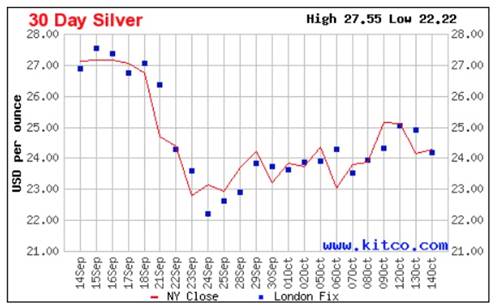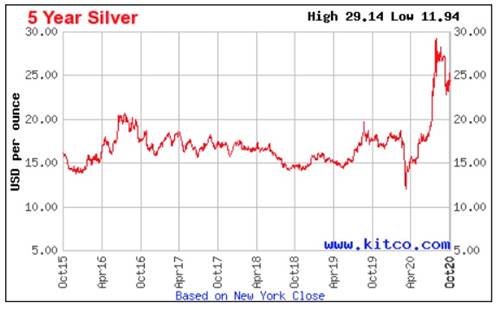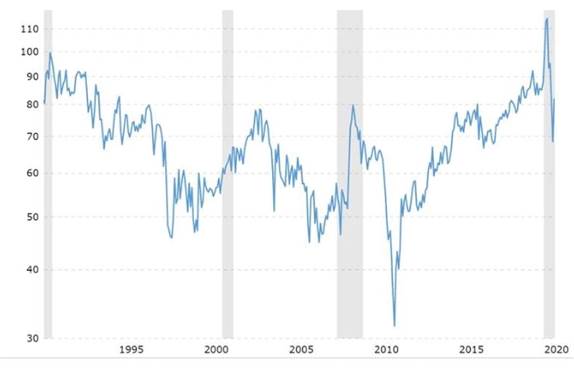Despite recent headwinds, it looks to be clear sailing going forward for silver, according to recent forecasts from three financial services firms.
“A higher gold price, along with the ongoing recovery in industrial demand, particularly from China, means that the price of silver is likely to rise in the year ahead,” Capital Economics said in a report published on Sept. 30.
“All in all, a market deficit in conjunction with a higher gold price should lift the price of silver to $25 and $27 per ounce by end-2020 and end-2021, respectively,” assistant commodities economist Samuel Burman wrote. He added,
“Demand for non-interest bearing safe-haven assets, such as gold and silver, should rise as real yields in the U.S. drift a little lower. We forecast that the US ten-year nominal yield will fall to 0.50%, from 0.70% currently, by the end of this year and that it will remain at this level in 2021. The Fed has already stated that it will keep policy ultra-loose until at least 2023 and allow inflation to overshoot its target.”
The London-based firm predicts gold will be back to $2,000/oz by year’s end. CIBC concurs that gold is likely to push higher, reaching $1,925/oz in the third quarter and $2,000 in the fourth, for a full-year average price of $1,800. The Canadian bank has also raised its longer-term gold price forecasts, to $2,300 an ounce in 2021, $2,200 in 2022 and $2,100 in 2023.
As for silver, CIBC estimates a run up to $32/oz in 2021, $31 in 2022 and $30 in 2023. This year it expects the white metal to hit $25/oz in Q3 and finish the year at $28/oz.
“The outlook for continued low real interest rates, increasing government debt burdens coupled with geopolitical uncertainty arising from the upcoming U.S. election are all supportive of further significant price appreciation,” the bank’s analysts wrote in a research note to clients.
Silver, it says, “has potential to provide investors with even more torque given the relatively smaller market for silver vs. gold.”
Raymond James also raised its silver price forecasts for 2021, to $25 an ounce, 37.9% higher than its previous call, and to $22.50 in 2022 - a 25% increase. The brokerage firm uses a model that bases predictions on the gold-silver ratio. Its current model uses an 85:1 ratio to estimate silver prices, and an 80:1 ratio for silver prices in 2021, 2022 and further out.
“Our price forecast changes reflect our views that the significant increase in monetary stimulus and Central Banker indications that interest rates are expected to be lower-for-longer have created a macroeconomic back drop that supports increased investment demand for gold, driving prices higher,” the Raymond James analysts wrote in a research note.


We have seen the gold-silver ratio decline from a multi-decade high of 127:1 in March, to the current 78:1, meaning it takes 78 oz of silver to buy 1 oz of gold. This is still high by historical standards, meaning silver remains undervalued compared to gold, and will likely move higher, towards the average historical ratio of 55:1.

Burman, of Capital Economics, thinks silver prices should gain momentum on the back of ongoing fiscal stimulus in China, and greater industrial activity which drives around half of annual silver consumption. He points out the latter will be helped by governments investing in green energy, including solar panels which contain silver paste.
The solar power industry currently accounts for 13% of silver’s industrial demand.
More and more silver will be demanded for its use in solar photovoltaic cells, as countries move further towards adopting renewable energy sources. Around 20 grams of silver are required to build a solar panel. The Silver Institute predicts 100 gigawatts of new solar facilities will be constructed per year between 2018 and 2022, which would more than double the world’s 2017 capacity of 398GW.
According to a recent report by CRU Consulting, the amount of electricity generated by solar power is expected to increase by 1,053 terawatt hours (TWh) by 2025, which is nearly double what was produced in 2019.
All of that solar will be a major boon for silver.
CRU expects PV manufacturers to consume 888 million ounces of silver between now and 2030. That’s 51.5 million oz more than the combined output from all the world’s silver mines in 2019.
A study last year by the University of Kent found that rising demand for solar panels is driving up silver prices.
5G technology is set to become another big new driver of silver demand.
Among the 5G components requiring silver, are semiconductor chips, cabling, microelectromechanical systems (MEMS), and Internet of things (IoT)-enabled devices.
The Silver Institute expects silver demanded by 5G to more than double, from its current ~7.5 million ounces, to around 16Moz by 2025 and as much as 23Moz by 2030, which would represent a 206% increase from current levels.
Although weak consumer confidence because of the pandemic has crimped demand for some of silver’s end uses, including autos and consumer electronics, governments’ recently announced infrastructure investment programs are expected to lift silver industrial demand.
On the supply side, among a second wave of covid-19 shutdowns this summer (the first wave was in March) were some of the biggest producing silver mines in the world, although some production has come back online.
In July, mining companies in Peru were forced to keep operations suspended, and halt new ones, as the number of coronavirus cases soared. Among the companies affected were Trevali and its Santander silver mine, Hochschild Mining’s Inmaculada, and Fortuna Silver Mines’ Caylloma. Investment projects such as Anglo American's $5 billion Quellaveco, Minsur's $1.6 billion Mina Justa and Chinalco's $1.5 billion Toromocho expansion have been delayed by several months.
In Mexico, the world’s largest silver producer, a surge of covid-19 cases in March led to the suspension of non-essential services. Among the companies forced to temporarily halt their operations, were Newmont Mining, Argonaut Gold, Pan American Silver, Sierra Metals, Excellon Resources and Alamos Gold.
The Silver Institute is predicting a 13% decline in silver production from Latin America this year - equivalent to 67 million fewer ounces - with global supply set to fall 7.2%.
Given both supply and demand factors, Capital Economics estimates the silver market will remain in a small deficit, right through to 2022.
Richard (Rick) Mills
aheadoftheherd.com


